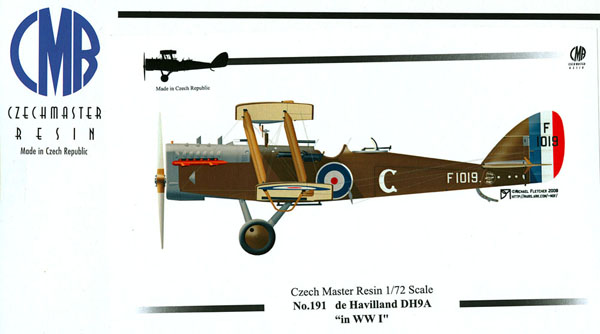
Czech Master Resin 1/72 DeHavilland DH-9A
By John Alcorn
GENESIS
The AIRCO/DeHavilland DH-9A was an evolutionary development of that company's DH-4 and DH-9 single-engine, two-seat biplane general-purpose bombers.
The DH-4 had proven to be a very successful type since its service introduction in October 1916. Powered primarily by the exemplary Rolls-Royce Eagle engine of 250/275 hp, it was, without doubt, the Royal Flying Corps' (RFC) best airplane in this role.
However, its primary weakness was placement of the main petrol tank between the pilot and observer/gunner, which seriously hindered in-flight communication between them. Also it placed the pilot at severe risk of immolation/crushing in the event of a hard crash landing.
This flaw was rectified in the follow-on DH-9, for which the pilot was located aft of the main petrol tank and just ahead of the observer/gunner. However the DH-9 proved to be a retrograde development, due to the unreliability and insufficient power of its Siddeley Puma engine, which developed only some 230 of its intended 300 hp rating.
Therefore, in order to fulfill the urgent need for a DH-4 and DH-9 replacement with improved and reliable performance, AIRCO decided to adapt the DH-9 airframe to accommodate the 400 hp LIBERTY 12 that was approaching quantity production status in the USA. However, since AIRCO's design and production facilities were then fully committed to the DH-9 and twin-engine DH-10 programs, responsibility for the new design was assigned to Westland of Yeovil, Somerset.
In order to accommodate the increased horsepower and weight of the LIBERTY 12, and to ensure adequate range, payload (bomb) and altitude performance, the fuselage structure was strengthened and the wings marginally increased in area relative to the DH-9. However, as the result of this redesign effort and limited availability of the LIBERTY, the DH-9A was not available for operational service until late August 1918.
SERVICE THROUGH WORLD WAR ONE
The DH-9A began operations with No. 110 Squadron, which arrived in France on 31 August 1918 as part of the Independent (strategic) Force, RAF. (Recall that the Royal Air Force came into being on 1 April 1918, as a reincarnation of the Royal Flying Corps.) All the airplanes of 110 Squadron were "subscribed" (paid for) by the then richest man in the World: "His Serene Highness, the Nizam of Hyderabad" (India) - and were prominently marked accordingly on the forward fuselage. As a consequence, 110 was commonly referred to as “The Hyderabad Squadron”.
110's first mission was flown on 14 September by a dozen airplanes that attempted to bomb Boulay-Moselle aerodrome near Metz. Although only six found the target, all returned safely to their base at Bethincourt. However, 110's fortunes changed on 25 September when five of their twelve machines were lost during a mission to Frankfurt.
On 5 October, while bombing Kaiserslautern, the squadron lost four of their number to anti-aircraft fire and defending fighters. One of these was F1010, which came down almost intact. It was later displayed in the Berlin Air Museum. Hastily stored in a Berlin warehouse when RAF bombs threatened the museum in 1943, its remains were moved to Poland at War's end. There it languished until acquired by the RAF Museum in 1977 to become the only surviving DH-9A.
By War's end, 110 Squadron had lost 17 DH-9As to enemy action, while 28 more had been written off from various other causes.
The only other Independent Force DH-9A unit was No. 99 Squadron, which flew a mixed bag of 9s and 9As until the Armistice, although two other RAF squadrons took the 9A into action: Nos. 18 and 205.
Also, 53 DH-9As were used operationally by the US Marine Corps Northern Bombing Group, which began operations in September.
By War's end the RAF had acquired 405 DH-9As, 149 of which were in France.
After the Armistice on November 11, 1918, DH-9As served in Germany as part of the occupation forces. During this time they performed peaceful and mundane services - as personnel transports, on communication duties, and delivering mail to British servicemen. As demobilization progressed, most of the DH-9A squadrons were disbanded: 110 Squadron in August 1919, 18 Squadron in December 1919 and 205 Squadron in January 1920.
It is my understanding that Czech Master Resin will reissue this kit in the near future with decals and additional details depicting it in as used in its post war mission of “Policing the Empire”.
A PERSONAL AFFINITY FOR THE DH-9A
As a lifelong airplane enthusiast and builder of static scale models, I have a special interest in and affection for the "Ninak" - as the DH-9A came to be known in the 1920s.
It all began with a set of multi-view line drawings sent to me by my friend Doug Carrick of Stockholm (but really a displaced Scot) in about 1988. This soon led to an uncontrolled desire to render a "scratchbuilt" static scale model of the type in polystyrene plastic. Although thus armed with an accurate and detailed set of multi-view exterior drawings (Doug creates no other kind) I yet required, and began to prepare a complementary set of structure/interior drawings, based upon several good sources that I soon acquired. However, as some aspects yet eluded me, I contrived a special trip to England, and specifically to the RAF Museum at Hendon, wherein resides the only surviving example of this type (that once reposed in the Berlin Aviation Museum).
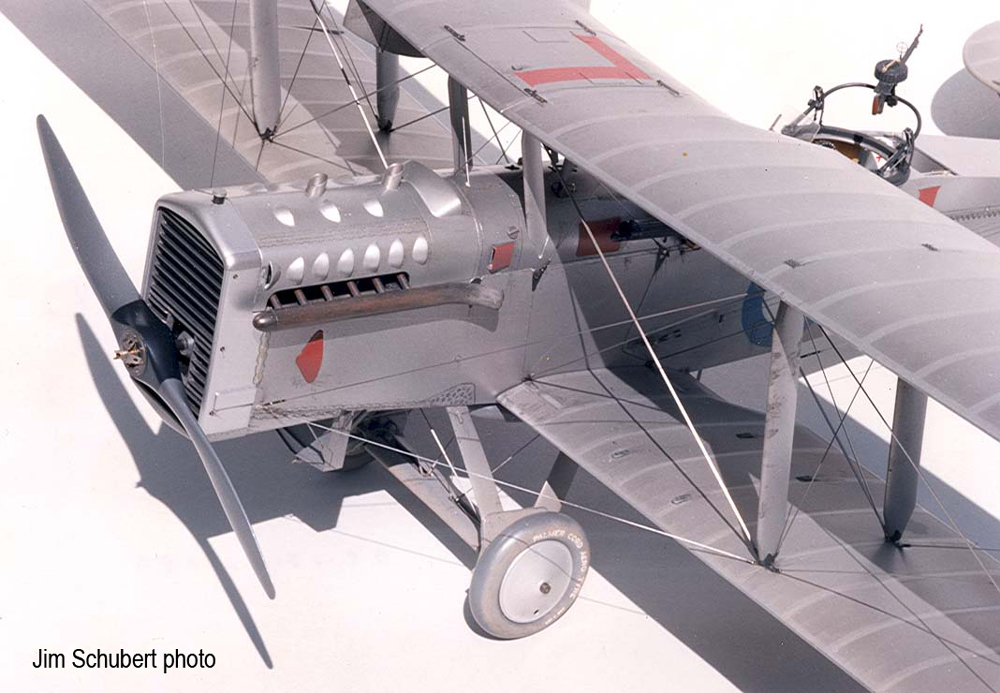 Then, over the next eight years (1990 - 1998) I constructed my modelling magnum opus - a 1/24th scale DH-9A, completed in the livery and configuration of H3510, "L" of No. 8 Squadron, based at Baghdad, 1924/5. During this time I maintained a daily construction log, which ultimately revealed that I had squandered 6400 hours of my life on this obsession over a period of eight years.
Then, over the next eight years (1990 - 1998) I constructed my modelling magnum opus - a 1/24th scale DH-9A, completed in the livery and configuration of H3510, "L" of No. 8 Squadron, based at Baghdad, 1924/5. During this time I maintained a daily construction log, which ultimately revealed that I had squandered 6400 hours of my life on this obsession over a period of eight years.
It garnered "Best Aircraft" at the 1998 IPMS/USA Convention in Santa Clara, California.
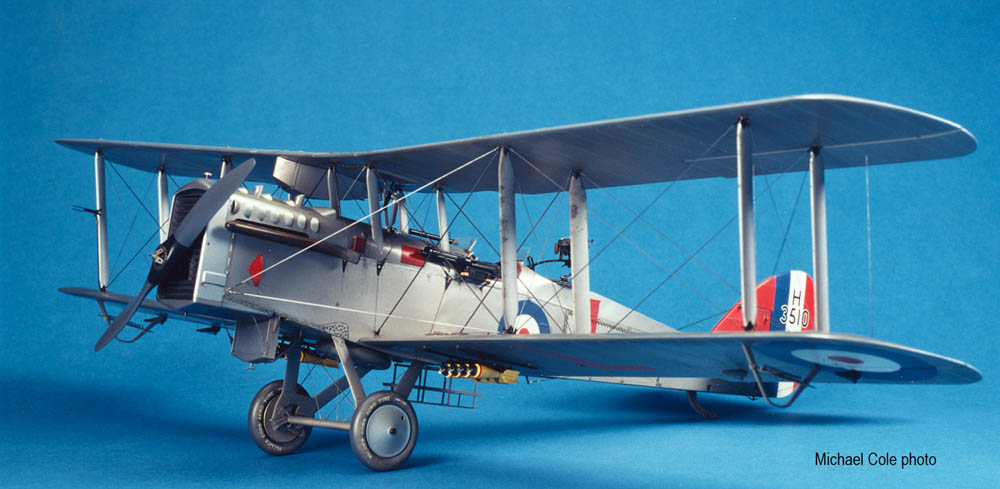 Then, against all good judgment due to its fragile nature, I took it to the 2000 IPMS/UK Convention, billed that year as the first ever IPMS/INTERNATIONAL, in Telford. There, to my utter delight and amazement, it was awarded "Best of Show". It was the high point, to date, of my 60-year modelling career!
Then, against all good judgment due to its fragile nature, I took it to the 2000 IPMS/UK Convention, billed that year as the first ever IPMS/INTERNATIONAL, in Telford. There, to my utter delight and amazement, it was awarded "Best of Show". It was the high point, to date, of my 60-year modelling career!
KIT REVIEW
This 1/72nd scale cast resin kit of the DeHavilland DH-9A comes packaged in a 26.0 x 16.5 x 3.5 cm white box, on the top of which is printed a very pleasing colour profile of F1019 from No. 205 Squadron by Michael Fletcher of Canada.
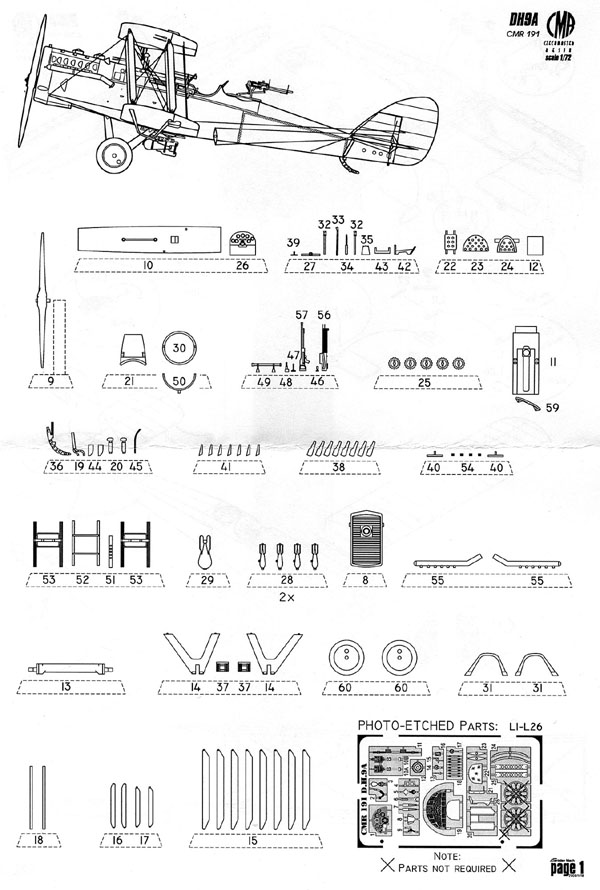 Instruction Sheets: Three sheets/six sides of line drawings:
Instruction Sheets: Three sheets/six sides of line drawings:
Each group of resin cast parts is drawn and numbered, mostly on page 1. This “Parts Map”, although a common feature of most Czech kit, is a new feature for CMR. The following pages contain isometric line drawings of components and subassemblies that pictorially describe assembly of the model. These are excellent, well-drawn, thorough visual instructions, with very few words - except for colour notes for wing struts, propeller, cockpit interior, &c.
Multi-View Drawings: These, presented on page 8, are quite accurate line/tone drawings, of detail appropriate for this 1/72nd scale kit. Page 7 features line/tone profiles - left and right sides of the three subjects for which decals are provided.
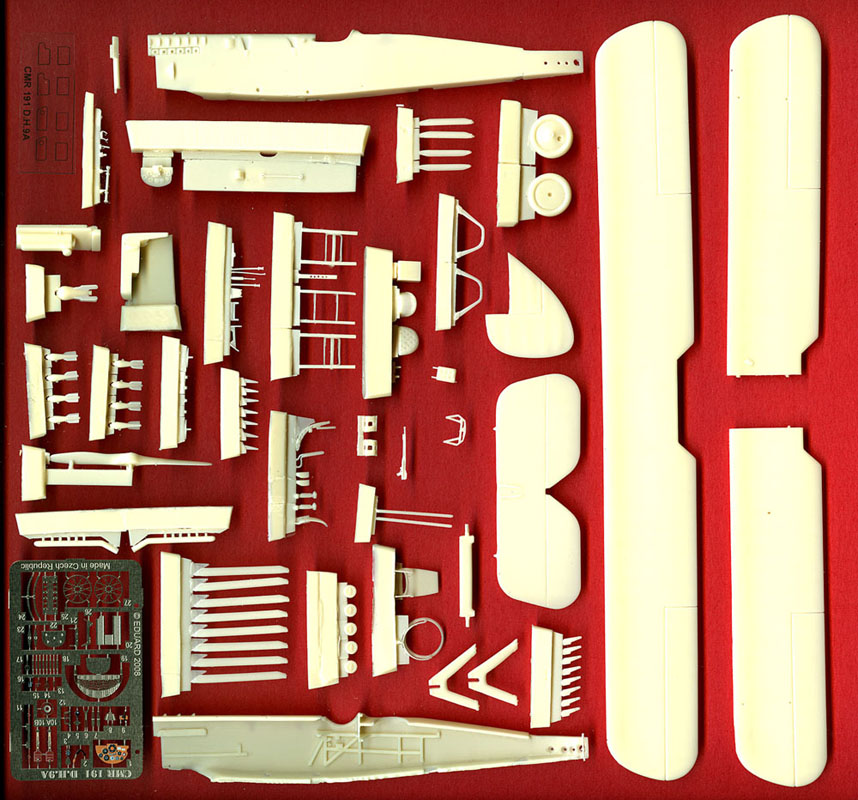 Resin cast components: With caveats noted below, the resin cast components are of the highest quality as regards shape and crispness, in a colour approximating clear-doped linen. The wing panels, however, leave something to be desired. In plan the top wing leading edge has a slight curvature forward, and is marginally narrow in chord at the center section. The chord narrows progressively toward the tips. This leading edge curvature could be eliminated by separating the outer wing panels from the centre-section. This is a surgical operation that should be performed in any case in order to impart the proper dihedral to the outboard panels; leaving the center section flat. The primary weakness, however, of the wing panels is the poor representation of ribs and inter-rib catenary sag. Spanwise, these features are only vaguely indicated by shallow undulations sans sharp representation of the ribs and no hint of rib-tapes. This condition could be corrected by very careful fore and aft abrasion using a rolled length of fine sandpaper and/or adding thin paper or plastic strip at each rib location, followed by airbrushing of filler and subsequent light fore and aft sanding with a roll of fine emery paper. An additional challenge would be restoration of the barely indicated leading edge partial ribs between each full rib. These comments apply also to the tail.
Resin cast components: With caveats noted below, the resin cast components are of the highest quality as regards shape and crispness, in a colour approximating clear-doped linen. The wing panels, however, leave something to be desired. In plan the top wing leading edge has a slight curvature forward, and is marginally narrow in chord at the center section. The chord narrows progressively toward the tips. This leading edge curvature could be eliminated by separating the outer wing panels from the centre-section. This is a surgical operation that should be performed in any case in order to impart the proper dihedral to the outboard panels; leaving the center section flat. The primary weakness, however, of the wing panels is the poor representation of ribs and inter-rib catenary sag. Spanwise, these features are only vaguely indicated by shallow undulations sans sharp representation of the ribs and no hint of rib-tapes. This condition could be corrected by very careful fore and aft abrasion using a rolled length of fine sandpaper and/or adding thin paper or plastic strip at each rib location, followed by airbrushing of filler and subsequent light fore and aft sanding with a roll of fine emery paper. An additional challenge would be restoration of the barely indicated leading edge partial ribs between each full rib. These comments apply also to the tail.
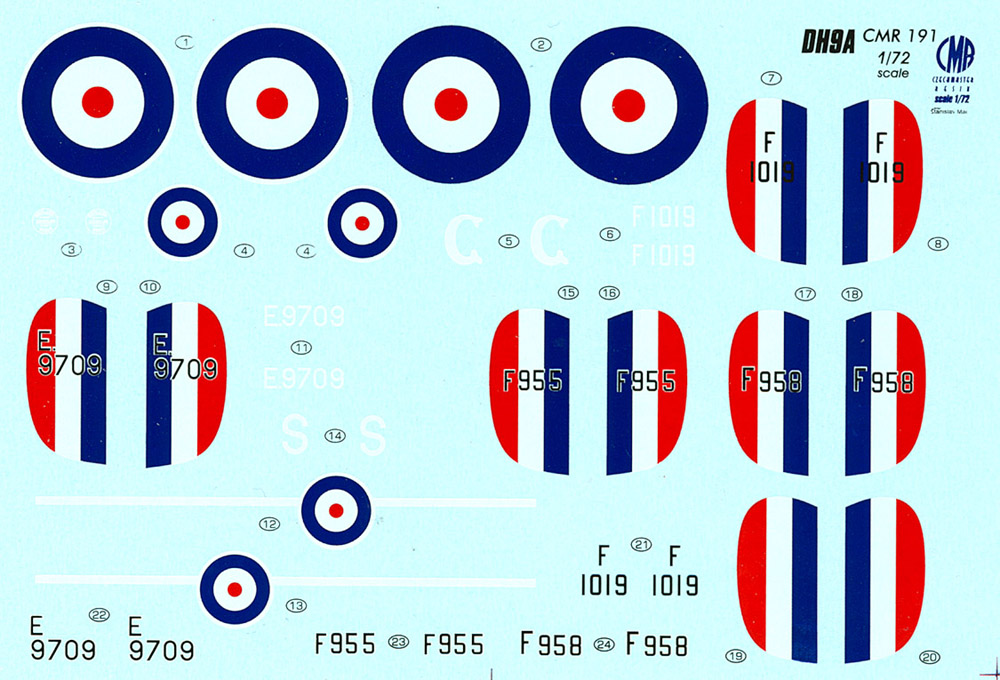 Decal sheet: These decals are of outstanding quality as to sharpness, registry and colour.
Decal sheet: These decals are of outstanding quality as to sharpness, registry and colour.
Photo etched plate: This small plate, produced by EDUARD, is also of the highest quality. Noteworthy is the fine surface detail on the simulated wicker seat, and colouring of the instrument panel and certain other elements.
Overall assessment: On balance I consider this kit to be of excellent quality, from which a competent modeller can fashion a worthy facsimile of this fine aeroplane.
REFERENCES
AIRCRAFT PROFILE 248 - De Havilland D.H.9A (R.A.F. 1918-30) by Chaz Bowyer, 1973, Profile Publications, Limited Coburg House, Sheet Street, Windsor, Berkshire SL4 1EB, England
RAF OPERATIONS 1918-1938, by Chaz Bowyer, 1988, William Kimber & Co., Ltd. 100 Jermyn Street London SW1Y 6EE, England
De Havilland Aircraft of World War One, by J.M. Bruce, 1991, Arms and Armour Press Villiers House, 41-47 Strand London WC2N 5JE, England
WINDSOCK INTERNATIONAL - Vol. 20, No. 3, May/June 2004, Article: DH9A COLOURS - PART 1, pp.10 – 24 ALBATROS PRODUCTIONS, LTD. 10 Long View, Berkhamsted, Hertfordshire, HP4 1BY, England
WINDSOCK DATAFILE xxx - DeHavilland DH-9A by John S. Alcorn, 2009, ALBATROS PRODUCTIONS, LTD. 10 Long View, Berkhamsted, Hertfordshire, HP4 1BY, England
